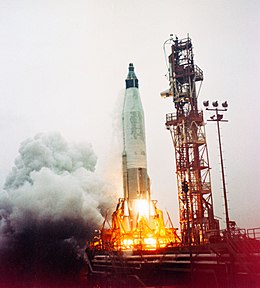
Back Mercury-Atlas 1 Afrikaans Мъркюри-Атлас 1 Bulgarian Mercury-Atlas 1 Czech Mercury-Atlas 1 German Mercury-Atlas 1 Italian マーキュリー・アトラス1号 Japanese Mercury-Atlas 1 LB Mercury-Atlas 1 NN Mercury-Atlas 1 Portuguese Меркурий-Атлас-1 Russian
 MA-1 liftoff | |
| Mission type | Test flight |
|---|---|
| Operator | NASA |
| Mission duration | 3 minutes, 18 seconds Launch failure |
| Distance travelled | 9.7 kilometres (6 mi) |
| Apogee | 13.0 kilometres (8.1 mi) |
| Spacecraft properties | |
| Spacecraft | Mercury No.4 |
| Manufacturer | McDonnell Aircraft |
| Launch mass | 1,154 kilograms (2,544 lb) |
| Start of mission | |
| Launch date | July 29, 1960, 13:13 UTC |
| Rocket | Atlas LV-3B 50-D |
| Launch site | Cape Canaveral LC-14 |

Project Mercury Mercury-Atlas series | |
Mercury-Atlas 1 (MA-1) was the first attempt to launch a Mercury capsule and occurred on July 29, 1960 at Cape Canaveral, Florida. The spacecraft was unmanned and carried no launch escape system. The Atlas rocket suffered a structural failure 58 seconds after launch at an altitude of approximately 30,000 feet (9.1 km) and 11,000 feet (3.4 km) down range. All telemetry signals suddenly ceased as the vehicle was passing through Max Q. Because the day was rainy and overcast, the booster was out of sight from 26 seconds after launch, and it was impossible to see what happened.
The mission was to conduct a suborbital test flight and reentry of the spacecraft. The capsule carried live separation rockets, but dummy retrorockets. Several other systems were not installed, including the cabin pressurization system and the astronaut couch. A number of Mercury engineers had voiced their objection to the launch because the weather would prevent observation of the flight. Some witnesses claimed to have heard an explosion, but this could not be verified. The capsule continued transmitting until it impacted the ocean, approximately 6 miles (9.7 km) downrange. Salvage brought the capsule, Atlas booster engines and LOX vent valve to the surface from the ocean floor. The engines showed no sign of damage except some deformation from impact with the ocean, but the vent valve and a still-attached segment of piping had noticeable fatigue cracks.
© MMXXIII Rich X Search. We shall prevail. All rights reserved. Rich X Search